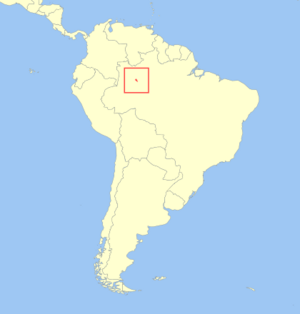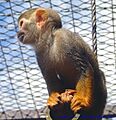Black squirrel monkey facts for kids
Quick facts for kids Black squirrel monkey |
|
|---|---|
 |
|
| Conservation status | |
| Scientific classification | |
| Genus: |
Saimiri
|
| Species: |
vanzolinii
|
 |
|
| Geographic range | |
The black squirrel monkey (Saimiri vanzolinii) is a small monkey found only in the central Amazon in Brazil. It's also called the blackish squirrel monkey or black-headed squirrel monkey. This monkey looks a lot like the female Bolivian squirrel monkey, but it has a black stripe down its back that the Bolivian one doesn't.
These monkeys have one of the smallest living areas of any primate. They live in a special type of forest called a várzea forest. This forest is found where the Japura and Solimões rivers meet. Their entire home is inside the Mamirauá Sustainable Development Reserve. They share this reserve with two other types of squirrel monkeys. Black squirrel monkeys are very social. They travel in large groups, called troops, which helps them stay safe from animals that might hunt them.
Contents
What Does a Black Squirrel Monkey Look Like?
Black squirrel monkeys are small. They usually measure about 27 to 32 centimeters (10.5 to 12.5 inches) long, not counting their tail. Their tail can be about 40 centimeters (15.5 inches) longer than their body!
Most of their fur is blackish-gray. But their legs can be yellow or reddish, and their stomachs are yellowish. Their fur is short and thick, except on parts of their face. They don't have hair around their nose and lips, and the skin there is black.
Male black squirrel monkeys weigh about 0.6 to 1.2 kilograms (1.4 to 2.7 pounds). Females are a bit lighter, weighing about 0.6 to 0.9 kilograms (1.4 to 1.9 pounds).
Special Features
They get their name from a black stripe that runs from their head all the way to the end of their tail. The black fur above their eyes forms a gentle curve. Their tails are also thinner than those of the Common squirrel monkey.
How Long Do They Live?
In the wild, black squirrel monkeys usually live for about 15 years. If they live in zoos or special care, they can live even longer, sometimes up to 25 years.
Where Do Black Squirrel Monkeys Live?
Black squirrel monkeys live only in the Mamirauá Sustainable Development Reserve in Brazil. This area has a unique várzea forest that floods regularly. Heavy rains can cause the water level in the forest to rise by about 35 feet (10.5 meters)! Too much flooding for too long can be a problem for their homes.
Sharing Their Home
Two other types of squirrel monkeys, the Humboldt's squirrel monkey and the Ecuadorian squirrel monkey, also live in this reserve. Black squirrel monkeys live in a smaller part of the reserve compared to the other two species. All three types of monkeys interact, but they don't seem to have babies together.
Why Are They Endangered?
The black squirrel monkey is considered an endangered species. This is because they live in such a small area of the várzea forest. Changes in the climate, like global warming, are also a threat to their habitat and their lives.
How Do Black Squirrel Monkeys Behave?
These monkeys are very social animals. They live in large groups, usually with 40 to 50 monkeys. Sometimes, these groups can be as big as 500 monkeys! Traveling in big groups helps them stay safe from predators. With more eyes watching, they can spot danger faster and warn the others. A large group might even be able to scare away some predators.
How They Talk
Black squirrel monkeys are usually quiet. They only make noise when they sense danger or when they want to call out to other monkeys in their group.
Having Babies
Black squirrel monkeys usually have their babies between September and November. During this time, male monkeys with bigger, rounder stomachs are more attractive to females. A female monkey is pregnant for about 140 to 170 days. Babies are born when there is plenty of rain and food available.
What Is Their Role in Nature?
Black squirrel monkeys are part of the food chain. They can be hunted by snakes, birds of prey (like eagles), and wild cats.
These monkeys eat many different things, which means they are omnivorous. They love to eat fruit and insects. But they also eat leaves, flowers, seeds, eggs, and small vertebrates (animals with backbones).
Why Are They Important to People?
Black squirrel monkeys are important in a few ways. They are sometimes studied in medical research to help us learn more about health. They are also sometimes kept as pets, though this is not always good for them. Because they live in such a small area, they don't cause any negative problems for the economy.
Gallery







